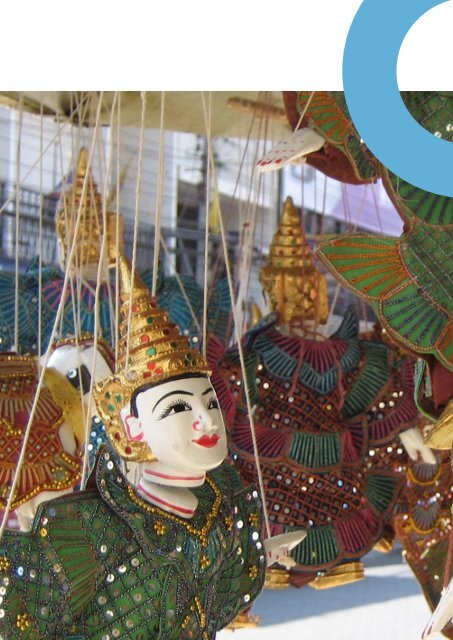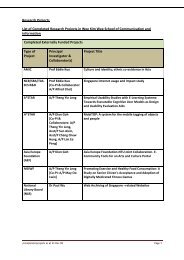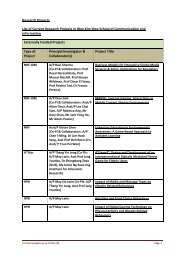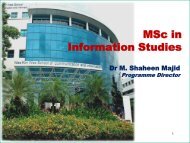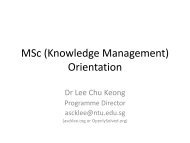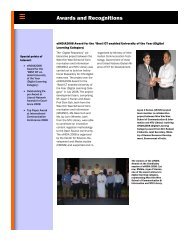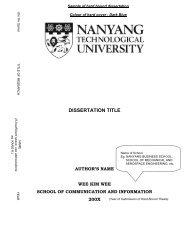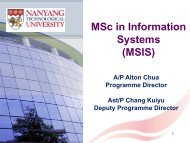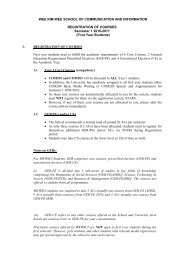Connexscions Volume III Issue 02 Jan - May 2007 - WKWSCI Home
Connexscions Volume III Issue 02 Jan - May 2007 - WKWSCI Home
Connexscions Volume III Issue 02 Jan - May 2007 - WKWSCI Home
You also want an ePaper? Increase the reach of your titles
YUMPU automatically turns print PDFs into web optimized ePapers that Google loves.
CHAIRʼS MESSAGEDr Ang Peng Hwa.As you must know by now, theSchool was officially renamedthe Wee Kim Wee School ofCommunication and Informationlast December in a major launchevent and at the Istana no less.What does it mean for theSchool?The new name of the School is abranding. It says that the School isnot an ordinary school. Someonehas deemed it special enoughto have a name attached to it.Convention has it that with thenew name comes additional funding.And that means our School,special as it is, will have the opportunityto scale greater heights.In principle, the School has informeddonors that roughly 40percent of the funds will be usedfor financial aid, 40 percent fornew programmes and initiativesand the remaining 20 percent willgo to hire professionals.It should be noted that the full impactof the $27 million will onlybe felt in 2012; most of the donorshave pledged their donation overfive years. Government dollarfor-dollarmatching takes effect ayear after the donation has comein. And what is used is the fruit ofthe investment of the money at theend of the year.The gradual build-up of fundssuits us fine. It allows us to plan touse the money more systematicallyand carefully.For the coming year, the funds willbe used almost entirely for financialaid. This does not just refer toscholarships and bursaries. Anincreasing number of our studentsnow have their papers acceptedat international conferencesor productions showcased infestivals. We also want to supportstudents who take up internshipsin less well-paying positions in theregion.For new programmes and initiatives,we count GO-FAR (GoingOverseas for Advance Reporting)and its kin. We recently startedSOJOURN (Short OverseasJournalism) where students wentPhoto by Mr Ng Heng Gheeto Chiang Mai for a week to dotravel writing. The other divisionswill embark on similar programmesto expose students to developmentsin the region.For hiring top faculty, we are consideringinviting media professionalsto spend time in the School.They could write a book, give theoccasional lecture, and generallyspend time with faculty and students.This arrangement benefitsboth the industry and the School.The end result will be a strongerSchool. Stronger not just becausethe programmes are strong andthe environment is stimulating.But stronger because both facultyand students are freer to imaginenew programmes and initiatives.Where we are going, imaginationis superior to knowledge. Imaginethat!Best Regards,Ang Peng HwaChair4 CONNEXSCIONS
Red Letter Day:Launch of<strong>WKWSCI</strong>By Priscilla Soh and Elane LuoEven the rain could not dampen the high spirits ofmore than 400 guests and staff at the Istana. Everyone,including the guest-of-honour, President S.R. Nathan,turned up on December 5, 2006 in their batik best tocelebrate SCI’s renaming as Wee Kim Wee School ofCommunication and Information (<strong>WKWSCI</strong>).Guests who had donated $1,000 and above to the WeeKim Wee Legacy Fund were invited to the dinner andgiven a goodie bag which included a special <strong>WKWSCI</strong>calendar filled with award-winning photos by Ms LimSiao Lang (2006) and Ms Lin Ziyu (2006). Guestswere also presented with a commemorative book, Onthe Record: The Journalistic Legacy of President Wee KimWee. The cover of the book was specially designed andfeatured a collage of articles written by the late Dr Weeduring his journalist days.The <strong>WKWSCI</strong> Organising Committee, headed byAssistant Professor Dr <strong>May</strong> Lwin, took painstaking effortsto plan the entire event. Nearly every aspect of theevent involved the School’s students and graduates. MsDiana Ser, a 2003 graduate from the Master of MassCommunication programme, hosted the event. A YearOne student, Ms Rasiah Raslyn Agatha, coordinatedthe event and UNIC Productions, a Final Year Projectgroup, assisted in the event.With the combined efforts of everyone at NTU,<strong>WKWSCI</strong> and graduates of the School, more than $27million was raised for the Legacy Fund, exceeding theoriginal target of $25 million. The fund will not onlygo towards supporting scholarships, bursaries, facilitiesand research but will also allow <strong>WKWSCI</strong> studentsmore overseas learning opportunities such as theGO-FAR (Going Overseas For Advanced Reporting)programme, which has already taken students to placessuch as Nepal, Aceh and Sri Lanka.Photo montage of the launch of <strong>WKWSCI</strong> at the Istana.6 CONNEXSCIONS
Photos by Ms Chan Huiyi & <strong>WKWSCI</strong> photographersCONNEXSCIONS7
A UNIC RebrandingExperienceBy Priscilla SohWinning T-shirt designby Year One student,Mr Lim Chee Harn.The Wee Kim Wee School of Communication andInformation has been thus renamed, to honour the lateDr Wee Kim Wee, ex-president, diplomat and journalist.However, the renaming has led to some concernsthat the School was narrowing its focus to thatof a journalism school. Such concerns are unfounded.<strong>WKWSCI</strong> continues to hold all of its divisions in highregard and remains student-centric.UNIC Productions, a team of four Final Year Publicand Promotional Communication (PPC) students,Ms Priscilla Soh, Ms Yvonne Koh, Ms Sam Shu Huiand Ms Chan Huiyi, initiated a rebranding campaignto increase awareness among current and prospectivestudents on the renaming of the School. More importantly,the group wants to help the School continue toattract top students from junior colleges and polytechnics,particularly in light of competition from schoolssuch as University of New South Wales and NationalUniversity of Singapore, which are now also offeringcommunication programmes.What makes <strong>WKWSCI</strong> different from other communicationschools is its single-minded vision to makeevery student who walks through its doors the best.This is also what the rebranding campaign aims tocommunicate to current and prospective students. Toproject a consistent identity, the school colours, blueand white, were used throughout all collaterals.As part of <strong>WKWSCI</strong>’s aim to maintain its reputationas a premier communication school in the region,UNIC Productions did presentations and talks at suchevents as career fairs, open houses, tea receptions andworkshops, to reach out to prospective students. Oneteam member, Yvonne, mentioned, “Because studentsnow have more options to choose from, a strong schoolidentity is needed to attract students to enroll here.They need to feel attached to the School even beforethey enter.”With this view, the team approached their presentationsfrom a personal perspective, and made the presentationsinteractive. As Final Year communicationsstudies students who have gone through all aspects ofschool life, they were more able to capture the interestof potential students with relevant examples from theirown personal experiences and views. Junior collegeand polytechnic students and even potential mastersprogramme students could access an unofficial blog8 CONNEXSCIONS
to enquire more about <strong>WKWSCI</strong>. With a greater understandingof the quality education that <strong>WKWSCI</strong>offers, it is hoped that more high-calibre students willplace the school as their top choice.The rebranding exercise also reached out to current<strong>WKWSCI</strong> students. UNIC Productions held a T-shirtdesign competition to give students a chance to help theSchool create its new identity. In the competition, theparticipants had to incorporate the letters, “<strong>WKWSCI</strong>”into the design of the T-shirt. Subsequently, the entireschool voted for its favourite design via means of a blog(http://wkwsci.livejournal.com). The winning designwill be incorporated onto T-shirts to be distributed toand worn by students, creating in them a sense of belongingto the School.The FYP team also assisted in organising the <strong>WKWSCI</strong>launch at the Istana in December, allowing them toshowcase their rebranding efforts to the School’s variousstakeholders.Being able to work on a topic so close to their heartsmade this project a truly UNIC experience for theseFYP students. Priscilla summed it up perfectly, “ThisFYP has been really special for us because we can makea positive difference to the School before we graduate.It’s our way of saying thanks to everyone at <strong>WKWSCI</strong>for making our four years in school so memorable.”The FYP team in front of the Istana at the <strong>WKWSCI</strong> launch.Photo courtesy of Ms Chan HuiyiVisitors from around the WorldVistors from Taiwan’s ChengChi University touringThe Nanyang Chronicle room.Visitors from China’s Zhejiang University.Dr <strong>May</strong> Lwin hosting visitors fromZayed University, UAE.Photos by Mr Ng Heng GheeCONNEXSCIONS9
AWARDS & RECOGNITIONMediaCorpNewsAwardsWinnersBy Lau LongqingIn early February, the MediaCorpNews Awards ceremony was heldto recognise and honour talentsfrom different platforms withinthe MediaCorp group – television,radio and print. A panel oflocal and foreign judges selectedthe winning entries, which werebroadcast or published last year.Four <strong>WKWSCI</strong> alumni emergedtop in their respective categories.The award trophies.Photo courtesy of Ms Sharon HunAng Ka Swan (2000)“Frontline: Midnight Cat Killers”took home the Story of the Yearwith Public Participation Award.The unique aspect of this award isthe emphasis on public participation,since the story came aboutdue to tip-offs from the public.Ms Ang Ka Swan explained thatafter receiving a tip-off informingof a spate of mysterious cat killingsat Jurong East Housing Estate,Frontline decided to head down toinvestigate. As they unravelled further,they discovered it was not anisolated case because there were catkillings in other parts of Singaporetoo. As such, they decided to dothis story to raise awareness aboutanimal abuse in Singapore.For a programme of such nature,Ka Swan feels that visual evidenceis necessary to highlight the crueltyof the act and to bring the messagestrongly across. She also believesthat it is essential for cat lovers tocome forward and talk about whatthey had witnessed with regardsto the cruelty of the cat abusers.However as the culprit for theJurong East abuse was not yet arrested,many of them were hesitantto do so and only one braveindividual came forward. Wheninterviewing the others, Ka Swanhad to film their legs and backs inorder to protect their identities!Ms Ang Ka Swan.Photo courtesy of Ms Ang Ka SwanAs the producer for this programme,Ka Swan spent many latenights filming and piecing the storytogether. She is delighted thather efforts have been recognisedand she feels that credit should beextended to the whole productionteam. “This is the first award thatI have received after six and a halfyears in the mass media industry,”she said. “I am extremely happyand honoured to win such a bigaward.”***Derrick Augustine Paulo (2004)Senior Reporter of MediaCorp’sToday newspaper, Mr DerrickPaulo, took home the Journalist ofthe Year Award. He said winningthis award was, “Overwhelming!”He explained that he feels a journalistshould be behind the camerainterviewing people so it was quitea different feeling for him to be inthe spotlight receiving the award.“After all, the focus should not beon the messenger but on the message.”10 CONNEXSCIONS
Covering the sections on education,media, politics and policy inToday, he feels that the challengein journalism lies in sourcing forrelevant information. Though passionateabout journalism, he commentedthat a lot of hard work isinvolved. He added with a laugh,“Guess it’s good to do it now whenI’m still young.”Viewing this award as a vote ofconfidence for him and Today, hesaid the nature of his job has notchanged after winning the awardas it is still about getting the storiesdone. In addition, Derrickthinks that although part of beinga journalist does involve workingindependently, it is also essentialto have a good team behind you tomake the news stories successful.Thus, he wishes to thank all thepeople he has learned from, as wellas all the colleagues with whom hehas worked.Did Derrick have any tips for buddingjournalists from <strong>WKWSCI</strong>?He said, “Be mindful of your duty.Think of the public and your newsmaker.Stay objective and stick tothe principle that you should reportwithout fear or favour.”Mr Derrick Paulo.Photo courtesy of Mr Derrick PauloSharon Hun Ee Lin (1999)When Ms Sharon Hun heard thather production “Indonesia: Onthe Ring of Fire” won the FeatureStory of the Year Award, the onlything that went through her mindwas, “I didn’t prepare a speech!”She said, “The exhilaration was notimmediate. When it did sink in, Iwas just happy that the efforts ofeveryone who was involved in theproduction were recognised. I wasjust glad that the story I had beeninvolved in could make the impactthat it did.”It was immediately after theBantul earthquake that her executiveproducer was moved tocome up with this documentary.“All over Indonesia, the people regardtheir country as their tanahtumpah darah, meaning that theirland is more than just a birthplace,”she said. “Since a lot hasbeen done about the plight of theIndonesians, as well as the aid thatwas given to them, we wanted todo something different – to lookat the tenacity and the mindsetof the Indonesians towards theircountry.”Sharon commented that everyproduction has its level of difficulty.She said, “The more challengingthe production, usuallythe more worth telling the story!Ironically, the most heart-wrenchingstories and the most wretchedstate of affairs make the best stories.”***Diana Ser (2003)“Get Rea! Fifty Dollar Men” wonthe News Story of the Year Award.The documentary brought to lightthe situation that Indian foreignworkers were providing sexualservices to men for $50 – hencethe programme’s name.As the presenter for this documentary,one of the challenges faced byMs Diana Ser was to get someoneMs Diana Ser.Photo courtesy of Ms Diana Seron camera for an interview. Theyknew of many foreign workerswho part-timed as sex workers,but none was willing to risk theirwork permit to appear on camera.Another difficulty was trying tostrike a balance between reportingon a social phenomenon, andbeing perceived as “promoting” acertain lifestyle.Diana said her motivating factorbehind every production she doesis the desire to tell a good story.This is coupled with the principlesof honesty, creativity and fairness.Asked how she felt when thisproduction received the award,Diana exclaimed, “Stunned!” Sheexplained she was certain theywere not going to win, as theyhad been nominated several timesfor regional awards and the closestthey had come was first runner-upat the Asian TelevisionAwards.As for thank you speeches, Dianasaid, “My mother, and of coursemy son, for not coming out prematurely.And my husband, forputting up with what he calls mymadness!”CONNEXSCIONS11
Getting to Know Her:Joanne PehBy Wang JingIt has been four years since she won the Miss Elegantand Miss Personality titles in the Miss SingaporeUniverse pageant, but Ms Joanne Peh (2006) continuesto charm Singaporeans with her dazzling smile andrefreshing looks. Recently, she was honoured with the2006 Nanyang Outstanding Young Alumni Award,which she said came as a pleasant surprise. “I feel I stillhave so much more to contribute, but this is definitelystrong encouragement.”During her student days, Joanne participated in numerousactivities. She enjoyed volleyball and tennis,and was a member of the (then) SCI Committee andCultural Activities Club. Outside of campus, she baggedMediaCorp’s Most Popular Newcomer Award and wasone of the Top 10 Most Popular Female Artistes in2004. The following year, she won her second Top 10Most Popular Artistes award. She has endorsed manyinternational brands, hosted several television showsand acted in a numberof television serials.Most recently, sheis filming a Chinesedrama in which sheplays a passionatebut sometimes brashsocial worker, whooften gets into conflictwith parents ofchildren with specialneeds.Ms Joanne Peh.Photo courtesy of Joanne PehJoanne said she did not really plan to pursue a careerin entertainment. “When I entered SCI, I saw myselfworking in the media industry but not as an artiste,more like a journalist.” However, she has no regretsabout the way things turned out and said the entertainmentfield is exciting, if very demanding with extremelylong days.Dr Ng – NanyangAlumni Service AwardeeBy Elane Luoasm to contribute to NTU came about through a longtimespecial affinity he feels for the University. “I feel athome here. There is a unique community in NTU.” In1998, he obtained his Master in Mass Communicationat (then) SCI.Dr Ng in La Plagne, France.Photo courtesy of Dr Ng King KangThe 2006 Nanyang Alumni Awards honoured Dr NgKing Kang (1998) with the Nanyang Alumni ServiceAward, bestowed on alumni who have volunteered theirservices and gone the extra mile in serving NTU.King Kang’s commitment to the University includesbeing a regular judge for NTU’s various song writingand singing competitions. Since 2000, he has alsobeen a guest speaker on creative writing at <strong>WKWSCI</strong>’sChinese Media Workshop. King Kang said his enthusi-King Kang is a senior correspondent with SingaporePress Holdings’ (SPH) Lianhe Zaobao newspaper. Hiscolumn focuses on lifestyle and he reports on variousproduct launches of cars and gadgets all over theworld, which involves extensive travel. He has alsowritten numerous books. Talking about his manyachievements, King Kang said, “2359 hours is the timethat I get inspired to write most, when my thoughtsflow!” That explains the title of his 15th and most recentbook, 2359, which consists of a collection of hisChinese column essays.King Kang said his work is tough and requires him tocommit long hours. But he has no regrets because heis passionate about what he is doing. His advice to studentsis, “Enjoy your work as if it’s your hobby.”CONNEXSCIONS13
PhD Graduate’sPaper Wins TopAwardBy <strong>Jan</strong>sen KohHaving graduated from (then) SCI with a PhD degreein 2006, Dr Chen Wenli joined the Learning SciencesLab (LSL) at the National Institute of Education(NIE). Although she did not have a great deal of priorexperience in educational research, she is enjoying thework as part of LSL’s research team. She said, “I find itvery interesting and exciting to investigate somethingthat has the potential to benefit education.”In December 2006, Wenli’s paper entitled“Incorporating online discussion in classroom learning:A new strategy” won the Best Paper Award in theInternational Conference on Computers in Education2006, a prestigious conference in the field of learningand education.The paper presented a new look at online discussion ineducation and learning. It implemented online discussionin a face-to-face classroom setting and evaluatedthe advantages and drawbacks of the practice for exploringthe applicability of adopting it as a new teachingand learning strategy.Wenli commented that winning this award was an encouragementto her to continue in her research of newmedia and education. She said, “Since receiving theaward, our paper has been included in several otherevents. Possible collaborations are underway with otherinstitutes who got to know about our project andour work this way.”Her research work in LSL includes computer-mediatedcommunication and virtual learning environment.Wenli intends to continue in the field of educationalcommunication and new media in education.Intan, Top YoungResearcherBy Genevieve SiewI had come to congratulate her for winning the Asia-Pacific Educational Research Association - EducationalResearch for Policy and Practice (APERA-ERPP) YoungResearcher Award 2006 and to have a short chat withher about that. But Ms Intan Azura was not the usualbookish PhD student researcher I was expecting tomeet. Barely had I settled into my seat and taken outmy notepad, when she chimed, “So, tell me aboutyourself first!” before breaking outinto a wide grin.And just like that, right from“Hello”, she set the tone of ourinterview session cum chat.Like a student on the firstday of class, she warmedme to the information Iwas to receive, and captivatedme with herstrong sense of dedicationand passion.I learnt how Intanfirst discoveredPhoto by Mr M Redhza A Rahim (MsIntan Azura’s husband)her calling to teach whilst giving tuition as an undergraduatestudent. While in NIE obtaining her postgraduatediploma in education, she was inspired byAssociate Professor Dr Agnes Chang to go further. Lastyear, on the encouragement of Dr Chang, she wroteand submitted a paper for APERA, to be published intheir official journal, ERPP. To her surprise, she earnedthe top prize in the APERA-ERPP Young ResearcherAward 2006, awarded to the best article submitted forpublication in the journal. She received the award at abanquet ceremony in Hong Kong, and was even askedto give a speech there.Upon congratulating her, the modest Intan smiled andsaid that her only wish was to see the paper published,before adding that winning the award was, however, awelcome and unexpected bonus which now gives hermore confidence to continue in her research work.Currently a 2006 Tan Kah Kee Postgraduate scholarPhD student in <strong>WKWSCI</strong> and part-time lecturer fora Masters programme, her research areas encompasseducation, with a focus on information studies. Thismother of two is also a volunteer at Mendaki, theMalay/Muslim community organisation. Having nowsubmitted her doctoral thesis, a full-time lecturer’s positionawaits her in Singapore Polytechnic.I asked her how she felt to be able to teach; her cheerfuland humble response was, “It is my way of giving backto the community.” Certainly, teaching is a noble professionbecause of teachers like Ms Intan Azura, wholeave one inspired.14 CONNEXSCIONS
FEATURESOh......Diya!By Zhang Zhang“Enigmatic, popular, tomboyishand amicable...” all these adjectivesare used to describe LydiaChan (Diya), a current Year Threestudent in <strong>WKWSCI</strong>. She recentlywon the Female Championshipof Channel U’s “Project Super StarII” competition.Dr Choi went to see the finalshow at the Indoor Stadium, togetherwith Assistant Professor DrAngela Mak and myself. Dr Choiremarked, “As teachers, we wantto give encouragement to studentswho strive for their dreams withpassion.”Singing “Paper Plane”.Asking what she thought she hasgained most from this competition,Diya answered in her blog,“Ifelt it was the whole experienceand also the friends I’ve met, especiallyCarrie (female first runnerup).Through this competition,I’ve also been able to really see theunity in my family and the lovethey have for me.”Diya’s family and friends arenot her only ardent supporters;<strong>WKWSCI</strong>’s students and staff alsogave her great support. AssociateProfessor Dr Alfred Choi, whotaught Diya in her first year at<strong>WKWSCI</strong>, said, “Lydia is a verycheerful and good spirited girl. Ihave been watching her performancesand giving her moral supportand phone votes. I also encouragedmy students to supporttheir schoolmate.”One of Diya’s best friends, MsChong Waiyin, who has beenextremely supportive of Diya toldme, “School with Diya around isalways full of surprises. One breaktime, we were at a loss where tohave our lunch, and the next thing Iknew we were heading for Sentosa!We took the luge ride and wentaround Sentosa on the monorail.And we definitely managed to rushback in time for our next class. Itwas totally a WOW experienceand our classmates were shockedto hear about our expedition. It’snot that often you hear of someonegoing to Sentosa during a breakbetween lessons.”Though Diya emerged as runnerupin the overall championship,she is truly a diva in our eyes.Diya, we are proud of you!Diya’s fansdressed in red.At extremeright is hermother.Singing “You Make Me Wanna”.Photo courtesy ofMediaCorpCONNEXSCIONS15
Photos by Ms Neo Xiaobin16 16 CONNEXSCIONS
Looking Beyond the PicturesBy Soohyun Yang“We all want to get nice-looking pictures. In the process,we often forget about the subject, that he or she is atalking, feeling, thinking human being.”When I walked into Advanced Photojournalism class,Assistant Professor Shyam Tekwani was talking aboutcitizen journalism, and a page featuring a picture,taken by a passer-by, of a burnt-down SBS transit busfrom The Straits Times was being passed around.Citizen journalism, also known as “participatoryjournalism”, has been made possible because of thetools of modern technology that allow people withoutprofessional training to take part in journalism.Mr Tekwani urged his students to look around theworld and be curious. “Curiosity is integral. Weneed to look beyond good strong visuals. We need tointeract with them.”By the patch of white paint in themiddle of his face – also known as xiaohua lian (half painted face) – Jian Rongis immediately identifiable as a chouor clown figure in the story, a characterthat is often unreliable and lacksdignity.Photo by Ms <strong>Jan</strong>e Huang18 CONNEXSCIONS
I followed up with two Final Year journalism students,Ms <strong>Jan</strong>e Huang Yingyu and Ms Yashi Wu, who havetaken up photojournalism for their Final Year Project.<strong>Jan</strong>e remembers her grandmother who used to takeher along to street opera performances when she wasyoung. Spurred by fond memories and her interest inChinese culture, <strong>Jan</strong>e decided to capture this dyingart in Singapore. “I think a lot of it has been lost tothe younger generation. It’s a real pity.” <strong>Jan</strong>e took picturesof children who chose to learn Chinese Opera astheir extra-curricular activity and also people who areinvolved professionally with it. While working on theproject she realised there was only so much one couldplan for, so she had to learn how to react quickly towhat was happening around her. <strong>Jan</strong>e said it was prettystressful but I was glad to hear she enjoyed workingwith the kids and got a great experience out of it.“Youth and Religion in Singapore” is the topic Yashichose to portray. Specifically she looked at Islam andChristianity in Singapore. Interestingly, Yashi herself isneither Muslim nor Christian.Tattoos on Adam’s knuckles, wrists and arms make it such that he has towear long-sleeved clothes all the time. These tattoos are reminders of hispast which motivate him to constantly seek knowledge about his religion.What did you learn while working on the project?I have learnt not to take things at face value and Irealised really how ignorant I used to be. I kind ofstereotyped Muslims and Christians and had my ownpreconceptions of them. I now know that if you sincerelywant to learn about someone, you’ll realise thateveryone has a story to tell. I have met and made moreMuslim friends in the past year than I had in the previous22 years of my life! And of course, I think in doinga year-long project, you have to persevere and keepworking on it. It is quite overwhelming how much Ihave learnt through the stories of these people and yet,religion is something unfathomable and something Ithink you can never truly understand.Ilda prays with her mother Madam Sapiah and sister Ida at home towardsthe direction of the qibla. “Women do not have to pray at the mosque butwe pray at home,“ said Mdm Sapiah.How did you feel about the ‘subjects’ while workingon the project?I’d call them my friends now rather than subjects. Iam grateful to those who have given me all the helpI needed to do this project. Not only did they openmy eyes, they touched my heart. They are wonderfulpeople who proved my preconceptions pretty wrong.It was a very long one year that I spent on doing thisproject and I am glad to be able to share with othersthe stories I have heard from these wonderful people.Check out the weekly photojournalism web magazine,eyewitness, where you can see the world through the eyesof <strong>WKWSCI</strong> students.http://www.ntu.edu.sg/sci/photojournalism/Zhi’en felt that she was reborn after she was baptised at Changi Beach onSeptember 9, 2006.Photos by Ms Yashi WuCONNEXSCIONS19
PROJECTS & PUBLICATIONSThe FYP group interview a woman at a food centre in Clementi.Photos courtesy of Ms Lo Hwei Shan‘SingaporeStandardTime’By Anisha Baghudanaand Zhang ZhangMs Joycelyn Khoo, Ms Serene Ng, Ms Lo Hwei Shan and Ms Loo Pei Yi (2006) hardly expected this sort of adulationfor their Final Year Project documentary “Singapore Standard Time”. The film won the MDA Book Prize2006 for Best Video Documentary, and then created waves at the National Museum where it was screened as partof the Cine.SG festival.The 27-minute documentary has also been shown at Thailand’s 10th Short Film and Video Festival Programme,at Singapore’s Asian Film Symposium, and at press time (March) had just completed a run at the Emirates FilmCompetition in Abu Dhabi, United Arab Emirates.“When I look back at it now, all the hard work has definitely paid off, and not just because we won a prize orbecause the documentary’s been screened,” Hwei Shan said on her experience. “There’s this wonderful sense ofachievement of simply having completed a documentary that embodies an idea that, I truly believe, needed to beexpressed.”“Singapore Standard Time” explores the ways in which speed has taken root and been taken to new heights in aSingaporean culture driven by an ethos of efficiency and instant gratification. Could this culture of speed be a signof something more?20 CONNEXSCIONS
‘Innocencefor Sale’ onNational TVBy Lau Longqing<strong>WKWSCI</strong>’s Student Video Project, “Innocence forSale” was recently aired on national television. Feelingvery honoured their film was chosen to be shown onMediaCorp TV 12 Arts Central, the team of four, MrChua Puay Hoe, Mr Ishi Lau, Ms Joey Chiang andMs Lee Pei Ling (2006) felt it was a validation of theirFinal Year Project’s (FYP) production values and theyear-long effort they had put into the production.Prior to the broadcast on Arts Central, the film wasshown during an independently organised screening ofFYP videos in the School, and was also aired duringthe 6th Young Guns Film Festival at The Substationlast year. This 26-minute film aims to provide greaterinsights into the lives and plight of child sex workers inBatam, Indonesia. By zooming into the child sex situationin Batam, the team hoped to increase awareness ofsuch brutalities inflicted on children in the country.With no background in the Bahasa Indonesia language,it initially proved a real challenge for the teamto interact with local people to film the production.Pei Ling recalled that in the early days they even hadproblems ordering food for lunch, and had to rely onsomeone translating the menu for them. However, sheadded, by the time their video was near completion,they could easily recite in Bahasa Indonesia what theirIndonesian interview subjects said!Having enjoyed the interesting experiences during thecourse of the production, Pei Ling had this to sharewith current <strong>WKWSCI</strong> students: “Have fun doingyour FYP because this is the last one before you graduate!Push the boundaries and pursue stories that aredifferent!”The bottom line is to be adventurous.The team working on their film in Batam.Photos courtesy of Quadtopus ProductionsCONNEXSCIONS21
By Tee Xin YiHIV/AIDS – a disease that is stillconsidered as taboo by many inSingapore. How many of us are actuallyaware that up to date, therehave been almost 3,000 cases ofHIV/AIDS patients in Singaporesince 1985? Among these patients,do we know that nearly 1,000 havepassed away?Concerned with the global AIDSpandemic, reluctance to talk aboutor even acknowledge the existenceof HIV/AIDS and the increasingnumber of patients newlydiagnosed with HIV/AIDS inSingapore each year, Mr JonathanLiu Shuhan, Mr Adrian Tan andMs Wang Run chose to do theirpart in fighting AIDS throughtheir Final Year Project (FYP). Thisproject aimed to bring awarenessto the public and educate themwith correct information about thedisease, as well as help combat thestigmatisation and discriminationthat People with AIDS (PWAs)still face in the world today.“The Red Ribbon Initiative” wasa collaborative effort between theFYP group and SPH Unionworks’Radio 100.3FM. The radio series,recorded entirely in Mandarin,consisted of five episodes and wasaired weekly on 100.3FM, fromDecember 1 to 29, 2006.Trying to put together the programmeand making this projecta reality was no easy task for thethree members. Holding on totheir beliefs and objectives, thegroup actually turned down fundingfrom a government agency asthey felt their aims did not coincidewith those of the agency.Adrian said, “For example, for oneof our episodes on teens, while wesuggested that purely spreadingthe message of abstinence wouldnot be effective on our teenagers,we were advised that in order22 CONNEXSCIONS‘The Red Ribbon Initiative’to get the funding, we must playdown the usage of condoms andemphasise abstinence. This was agreat deviation from our originalintent, which was backed up withlots of research and professionaladvice.”He added, “We thus decided togive up on the funding and proceedwith a project that sent outthe message with an impact andnot stick with something that wefelt would fall on deaf ears.”Each episode, which was about 10minutes long, made use of a differentangle to shed light on thevarious parties related to the topicof HIV/AIDS. The first episodewas a radio drama that dramatisedthe story of an HIV-positive person,while the subsequent episodesfocused on key high-risk groupsand the challenges they faced.Interviews with relevant parties,such as patients, healthcare workersand volunteers, were also included.Shuhan, the technical specialist inthe group, said, “Using a highlypersonal medium such as the radio,we hoped to reach out to ourtarget audience more effectively. Atthe same time, this medium protectedthe anonymity of our subjectswhom we aimed to interview.Also, the project was packagedin Chinese because we felt thatThe FYP groupwith RadioFM100.3Programme &PromotionsDirector, WongWoon Hong, ontheir live broadcastday.Photo courtesy ofMs Wang Runthere is a lack of relevant resourcesthrough the right medium withinthe Chinese community when itcomes to AIDS awareness.”Like any other project, the groupmet difficulties while carrying outtheir FYP. Unlike other groupswho had till March <strong>2007</strong> to completetheir FYP, “ The Red RibbonInitiative” team had to rush theirsout by December 2006 in order tocoincide with World AIDS Dayon December 1. This was indeed achallenge, as they had to completethe production while juggling lessonsand examinations in school atthe same time.However, the members definitelyhad no regrets. This project hasgiven them much exposure andmany once-in-a-lifetime opportunities.For instance, they were ableto visit a halfway home for PWAs.The project also exposed themto people abandoned by society,heart-breaking stories and the devastatingeffects that HIV/AIDScan bring about.Wang Run concluded, “We alsolearnt how the virus can makesomeone stronger and cherish lifemore. Speaking to one of the HIV/AIDS patients, we discovered thatthe virus is not as scary in itself;the PWAs are more fearful of thediscrimination from society andrejection by one’s family.”
CrossingOver theBoundariesBy Isabel TanLIS professors and professionalsat the conference.Library and Information Science professionals have awealth of unique local expertise and exciting innovationsavailable in the Asian region, and no longer needto rely on the West for ideas and leadership. That wasone important lesson of The Asia-Pacific Conferenceon Library & Information Education & Practice (A-LIEP 2006) held at NTU in mid-2006. The conferencewas organised by (then) SCI’s Division of InformationStudies in collaboration with the Department ofInformation Science, University of Malaya, and NTULibrary.A-LIEP 2006 had the following aims:• to foster collaboration and cooperation among informationstudies schools in Asia;• to advance information studies education in Asia;and• to provide leadership and play a facilitator role inthe Asian region while raising its profile.The conference was an exciting gathering of 217 LIS(Library and Information Science) professors and professionalsfrom 20 countries. The participants rangedfrom heads of library schools, library directors andresearchers to graduate students who were presentingtheir first international papers. Keynote speakers whoshared their views at the conference included Dr N.Varaprasad, Chief Executive of the National LibraryBoard, who presented his vision of the 21st Centurylibrary service. Dr Peter Keen, Shaw FoundationProfessor at NTU, meanwhile, explained the new conceptof knowledge mobilisation and why it is more importantthan knowledge management.The conference reflected a growing awareness of theneed for more networking, dialogue and collaborationamong LIS educators and researchers in the Asia-Pacific region, who have perhaps sometimes beenunaware of valuable developments, innovations andexpertise within the region itself. Each country inPhoto courtesy of Dr Chris KhooAsia-Pacific has its own history of LIS education andresearch, shaped by socio-economic, political and culturalfactors, and therefore exhibiting a wide variety ofcharacters, flavours and areas of strength. It is hopedthe conference will stimulate greater collaboration andcooperation in the region as well as globally.To promote resource sharing among LIS educatorsand researchers, a Web portal for LIS education calledLibrary & Information Science Education in Asia(LISEA) is being developed, moderated by <strong>WKWSCI</strong>Associate Professor, Dr Chris Khoo, who played a keyrole in running the A-LIEP 2006 conference. “Thanksto everyone who played a part to make this conferenceso successful,” said Dr Khoo. “I am also currentlyworking with professors and colleagues in other countriesto develop an accreditation system for informationstudies education in Asia.”Dr Khoo is a firm believer that new-age libraries haveto be multi-talented. To lead by example, he got togetherwith a few colleagues to showcase their musicalflair by performing a short recital to entertain the conferencedelegates during their official banquet held atThe Pod, National Library Board.To further promote innovation and best practices ininformation services and systems, Dr Khoo is also runninga three-month research project with Ms Fan Fan,an exchange student from China’s Peking University.The project aims to analyse and compare Western andChina classification systems in selected subject areas.With <strong>WKWSCI</strong>’s Division of Information Studiesgaining more exposure in the Asia-Pacific region, moremajor international conferences are definitely in thepipeline. Dr Khoo said, “The A-LIEP conference isbecoming an annual affair with Taiwan organising thesecond staging in November <strong>2007</strong>, and Japan slated tohold the third A-LIEP conference in 2008.”CONNEXSCIONS23
Excuse Me, AreYou a TravelWriter?By Genevieve SiewImagine riding elephants, playing soccer with localvillagers, experiencing a village night-stay, trekkingthrough bush and white-water rafting – all as part ofcourse curriculum! For 10 Year Two <strong>WKWSCI</strong> studentswho recently spent five days in Chiang Mai,northern Thailand, this was exactly what they did.There to try their hand at travel writing in the newSOJOURN (Short Overseas Journalism) practicumintroduced this semester, the trip, however, involvedmore than just the fun it advertised.As rightly put by one student, Ms Sheere Ng, “Wedid what normal tourists wouldn’t do, and saw thingsnormal tourists wouldn’t see.” To that, Mr ChistopherOng, who played soccer with the locals, added, “Andbecause you have the obligation to collect facts, youmake more effort to make things happen.”This “Give me more information!” attitude of the studentsand commitment to their stories impressed MrAndrew Duffy, the lecturer who led the trip. Even moregratifying was seeing the students engaging and interactingwith their environment, as it meant the true lessonof travel writing had been well learnt. “You haveto be more than the passive tourist,” said Mr Duffy.“Don’t just ride the elephant. Find out what his nameis, what he eats. Find out who owns the elephant. Youfind out everything about the elephant – and that’s thedifference between a holiday and travel writing.”With the hope thatat least half its undergraduateswouldget the opportunityto travel overseas atsome point duringtheir four-year degree course, the new SOJOURNpracticum is similar to the GO-FAR (Going OverseasFor Advanced Reporting) programme, where studentsgo abroad to write news and feature stories.“Don’t just ride theelephant. Find out whathis name is, what he eats.”To land one of the limited places in the SOJOURNpracticum, applicants had to write a 500-word essayon what they hoped to gain from the experience, aswell as present a story idea. With ideas and topics suchas community service, monks and the idea of darknessin Thailand, a trip during the recess week was planned,with an itinerary that gave each of the students at leasthalf a day to explore and gather material for their articles.Structured in two parts, the six weeks of the courseprior to the trip were spent on travel writing lessons.Upon return from Chiang Mai, one-to-one discussionsessions with Mr Duffy focused on polishing the articles,before they were promoted to external publications.According to Mr Duffy, who was a travel writerand editor for five years, this was the biggest challengeof the course. “The students will have to make coldcalls, but we are showing them what it is like for freelancejournalists,” he said.Journey through Palong Village on Mae the Indian elephant.Photo courtesy of Mr <strong>Jan</strong>us GohStop Press:More Awards for‘Bachelor Farmer’The documentary video Bachelor Farmer (see <strong>Jan</strong>uary-<strong>May</strong> 2006 issue of connexscions) continues to receiveaccolades with the recent announcement of anAward of Excellence in the Broadcast EducationAssociation’s (BEA) Faculty Competition portion ofthe Documentary Division. According to lecturer MsNikki Draper, the film scored 94 out of a possible 100points. This competition is part of BEA’s annual conference,and the award will be presented at the conferencein April in Las Vegas, US.24 CONNEXSCIONS
Courtyard – Where Knowledge is SharedBy Isabel TanKnowledge is all about sharing with one another to gainmore insight. This spurred the creation of Courtyard– an online journal platform for the meeting of mindsfrom different areas to share ideas and knowledge.Beginning in December last year, this collaborationbetween the National Library Board (NLB) and NTUopens a virtual arena for people to share about howlibraries are operated, the way they do things and howto come up with new ideas for the users.Courtyard is moderated by <strong>WKWSCI</strong> AssistantProfessor Brendan Luyt and his co-editor, LecturerAndrew Duffy. It was initially launched as a quarterlye-journal, reaching out to a specific target audience,and aims at serving as an online platform for people toshare innovative ideas and viewpoints on research papers,projects and conferences. Practitioners thus havethe opportunity to share their practical work, whichallows a synergy of skills between the libraries. In addition,<strong>WKWSCI</strong>’s graduates and current students havea chance to showcase their best research papers, toshare their ideas and through discussion receive valuablecritiques of their work. This increases opportunitiesto get their papers published, which will benefitthem in the future.Previously, much of the NLB’s expertise was kept internally.Now, Courtyard aims for a wider distribution,to allow others to further develop their skills. Dr Luytsaid, "We envisage Courtyard as a project that will contributeto the development of a knowledge-sharingculture among the LIS community.”Specifically, Courtyard contains news, views and reportsfrom recent conferences to bring readers up-to-date reviewsof initiatives the NLB has taken, as well as newMs Ngian Lek Choh and Dr Schubert Foo putting their signatures to the project.Photo courtesy of Dr Brendan Luytresearch on information systems and knowledge management.The online journal comprises of four mainsections: 1) Emerging Fields, 2) Conference Reports,3) Events and Processes and 4) Research Reports,which makes it easier for people to navigate and searchfor information within the website.Courtyard represents a natural next step for the NLB,which is part of the Congress of South-East AsianLibraries (Consal). Ms Ngian Lek Choh, NLB DeputyChief Executive, said, “We often get requests from librariesall over the region, asking us to share with themthe way we do things. Library communities want tofind out about what others are doing, so Courtyardwill be a platform to share this kind of information.There are plans to expand Courtyard into a must-visitsite for interested people all over the world, so certainly,in time, Courtyard will definitely move beyondSingapore.”CONNEXSCIONS25
POSTGRAD NEWSGraduates of this programme are employed as informationprofessionals in a wide range of informationintensiveenvironments, including sectors such as defence,education, finance, publishing and the media.MSc in Knowledge ManagementPhotos by Mr Ng Heng GheeMSc Courses:Towards anEnriching EducationBy Isabel TanIn this issue, we find out more about the three MSccourses offered by the Division of Information Studies.Potential students interested to learn more details aboutthese courses can do so on the <strong>WKWSCI</strong> website.The aim of the MSc (KM) programme is to providegraduates who have relevant work experience with advancedprofessional training and postgraduate educationin Knowledge Management. The programme catersfor working professionals who are dealing with aninformation-intensive environment and who want tofurther their careers in modern knowledge-based organisations.This programme focuses on management, technologyand information topics that are essential for professionalsto meet the demands of employers in Singaporeand the region. Flexibility in the three-tier programmestructure allows students to further develop their relevantcore skills and specialised knowledge in order tothrive in the new knowledge economy.MSc in Information StudiesBeing multi-disciplinary, the Master of Science inInformation Studies programme draws upon the disciplinesof library and information science, informationmanagement, and information and communicationtechnology. This is reflected in the rich and variedprofessional and academic backgrounds of its internationalfaculty.Students admitted to the programme come from across-section of industries. They include teachers andpolytechnic lecturers, IT professionals, multimediaproduct developers, graphic designers, library managers,business managers, sales and marketing personneland more. This attests to the growing importance ofinformation skills, services and products in all economicsectors.The programme has been designed to provide flexibilityfor students to specialise in different areas. The fourareas of concentration offered are information systems,library and information science, information management,archival informatics and school media resourcemanagement, giving students the choice to pursue thefields in which they are interested.MSc in Information SystemsThe MSc (Information Systems) programme (MSIS) isa collaboration between <strong>WKWSCI</strong> and the School ofComputer Engineering (SCE). The programme blendstheory and practice so as to equip students with advancedknowledge necessary for the design, development,maintenance and management of informationsystems.The training includes exposure to the latest technologiesused in the development of information systems,as well as core skills required to cope with the rapidlychanging nature of the field. To this end, the MSISprogramme is broad-based and covers a range of technicaland soft skills that an Information Systems professionalis expected to possess. These include softwaredevelopment and infrastructure, to give students a coreknowledge required for the design, development andmaintenance of information systems; human computerinteraction, which includes the knowledge for designinginformation systems that are both useful andusable from an end-user perspective; and managementof systems and services, which teaches the soft skillsrequired for managing information systems projects,information systems personnel and resources.26 CONNEXSCIONS
TEACHERSʼ NOTESNew Media,New FaceBy Aveline ChiokDr Marcel Machill.Photo courtesy of Dr MachillDr Marcel Machill, a visiting professor from theUniversity of Leipzig in Germany, hopes to contributeinnovative projects to <strong>WKWSCI</strong>. He has vast experienceas a journalist with several newspapers and publicbroadcasting services in France and Germany. Most recentlybefore coming to <strong>WKWSCI</strong>, Professor Machillwas professor of journalism and international mediasystems at the University of Leipzig.Joining the Division of Journalism and Publishing,he hopes to combine academic research and practicaljournalism. He said, “Doing investigative journalismhas a lot in common with doing research.” He willteach undergraduate courses in IT and New Mediaand Social <strong>Issue</strong>s in Science and Technology.Why did you choose to join <strong>WKWSCI</strong>?I am always looking for places which combine excellencein research and teaching, high professional standardsand a friendly and personal working environment.This combination is extremely rare; often, one elementis missing. But <strong>WKWSCI</strong> is truly a wonderful place.What is your specific area of research interest?My current focus is on digital gatekeepers. In view ofthe rising flood of information available in digital format,gatekeepers play an increasingly important role.Besides the classic gatekeepers such as journalists andtheir media products, users and journalists now facenew digital gatekeepers such as electronic programmeguides in digital TV, web portals and internet searchengines. Such instruments are important for the users’and journalists’ abilities to navigate and make use of theenormous amounts of information available. They connectus to the services and the sites we visit – needles ina haystack that could otherwise be inaccessible. At thesame time, the ways such gatekeepers are constructedhave implications for what services and contents are actuallyaccessible, and on what conditions.The issue of digital gatekeepers is one of the key issuesconcerning power in digital media. Research on whyand how such gatekeepers are developed, the role theyplay in the media markets, and the impact they have forthe working conditions of journalists are fundamentalquestions to address in order to develop a better understandingof a rapidly changing media landscape.Besides work, what sort of leisure activities do youengage in during your free time?Although I am a workaholic, I do love leisure activities.I like literature (very often, I read novels untillate at night), going to the movies, to the theatre andthe opera. I play handball, table tennis and like joggingand swimming. I adore good food and even betterwine - what a pity that I couldn’t bring my collection ofBordeaux and Rioja wines with me to Singapore!CONNEXSCIONS27
Joining <strong>WKWSCI</strong>By Aveline Chiok and Tee Xin YiMr Jayan Chirayath KurianHis passion for research drew him to <strong>WKWSCI</strong>. MrJayan Chirayath Kurian was previously a research studentat the University of Nottingham in Malaysia. Asthe School’s new project officer, his main role is to setup the NTU Dspace institutional repository, a digitalasset management system to capture, preserve and disseminatean organisation’s born-digital assets. He alsowishes to research on the feasibility of integrating semanticconcepts into Dspace.Ms Dawn TanMs Dawn Tan previously worked as Mediation Officer(CMC) in the Ministry of Law. Sensing that it was timeto venture into something new in life, she took on theposition of Secretary to Associate Chair at <strong>WKWSCI</strong>.Besides providing administrative support to AssociateChair Professor Schubert Foo, she also supportsAssistant Chair Dr Mark Cenite with the School’salumni relations. In addition, Ms Tan is a new programmeadministrator for the MSc in KnowledgeManagement (MSc-KM) and the Master of MassCommunication (MMC) programmes.She said, “It is not easy to remember so many namesand programmes, but my experience at <strong>WKWSCI</strong> hasbeen good so far. The people here are very helpful andthere are so many of them that I need to thank!”Learning More About AsiaBy Zhang ZhangProfessor Mark R. Levy, Professor and Chair of the Department ofTelecommunication, Information Studies & Media in the College ofCommunication Arts & Sciences at Michigan State University, US, fell in lovewith Singapore during his first visit to NTU in 1998. He is not only a renownedprofessor, but also a great fan of Asian culture. He said, “I want to be in a placewhere I can learn even more about Asia.”Currently at NTU as a Fulbright scholar, Dr Levy advises on strategic planningand mentors <strong>WKWSCI</strong>’s junior faculty members. He is also teachingInformation Society & Media Theory in the MMC programme. He said, “I findthe students here are just terrific. I really love them. The students here are topstudents; they are very strong and have many talents and gifts, and work veryhard.”Dr Levy with his grandchildren.Photo courtesy of Dr LevyDr Levy told me that just before our interview, he had met up with a formerstudent he had not seen for almost 10 years. He added, “For a teacher, it is awonderful reward to have your students be successful.”Dr Levy and his wife, Dr Diane Levy, are extremely fond of the food in Singapore,especially pepper crab. He exclaimed, “It’s very tasty. I can’t get pepper crab inthe US. We’ve been here a month and we have had pepper crab three timesalready.”He and his wife also enjoy getting around to see Singapore. “Shopping is a nationalsport in Singapore,” Dr Levy remarked. He often goes shopping with hiswife and tries to explore new places and do things in Singapore they have notdone before. He says it is a great way to familiarise themselves with the city andto know more about the local culture.28 CONNEXSCIONS
Ms Michelle RobertBefore she became <strong>WKWSCI</strong>’s Manager for GraduateProgrammes, Ms Michelle Robert had taught in primaryand secondary schools. She says teaching is herpassion but while doing her MSc in Creative Studiesand Change Leadership in New York, she realised herstrength in administration and decided to explore opportunitiesin this area.Her work at <strong>WKWSCI</strong> includes the running of examinationsand admission exercises, doing programmebriefings and marketing the School’s graduate programmes,handling student matters and ASEANscholarships, as well as playing a role in organising thisyear’s <strong>WKWSCI</strong> anniversary celebrations. She is alsothe point of contact between the Graduate Students’Office and <strong>WKWSCI</strong>. She said, “This job has beennothing BUT challenging! I am good at multi-taskingbut my current portfolio makes the multi-taskinga real challenge.”Ms Robert aspires to move into large-scale marketingfor the School some day. She expresses her wish, “I hopeto travel and spread the word about our programmesto the international audience. NTU is a world-classuniversity and <strong>WKWSCI</strong> offers attractive, valuableand up-to-date programmes which should reach outto not only our locals but also the international marketat large.”Mr Jeremy NgMr Jeremy Ng, <strong>WKWSCI</strong>’s new IT executive, hopeshis stay at the School will be a good experience thatwill help him in his future. His job is to provide ITsupport to all staff and postgraduates. Being his firstfull-time job, he hopes to take this opportunity toacquire more practical and relational skills. He said,“Having to work together with different people fromdifferent nationalities and cultures is definitely an eyeopenerfor me.”Experience the DifferenceBy Wang JingThe first things I noticed in his office were mathematical models and a fancy integration sign ∫ on the whiteboard.Astonished, I thought I was in the wrong place. Wasn’t it supposed to be a communication professor’s office? Well,it was. It was the office of the Wee Kim Wee Distinguished Professor Steven S. Wildman.Despite obtaining his BA to PhD credentials in Economics, Dr Wildman isengaged in Communication Studies. When he was a PhD student at StanfordUniversity, two of his dissertation advisors were both experts on the mediaindustry. That unique exposure drew his attention to media research. Hesaid, “It wasn’t my conscious design, but my natural interest. Media industriesare quite different from other industries. They are fascinating.”From his strong economic background, he adopts an economic approachto communication research. Sometimes he does mathematical modelling topresent the basic ideas and functions in a mathematical way, as I saw on thewhiteboard in his office.Dr Wildman is the James H. Quello Professor of Telecommunication Studiesin the College of Communication Arts and Sciences at Michigan StateUniversity. He is also the co-author or co-editor of five books, numerousarticles on economics and policy for communication industries, and is editorof the Journal of Media Economics.This semester, Dr Wildman has been collaborating with Assistant ProfessorDr Wayne Fu on a research project on the economic characteristics of televisionaudiences. He is also teaching an MMC course on Economics of Media.In reply to what brought him to <strong>WKWSCI</strong>, Dr Wildman said, “Several reasons,but the most important being the School’s excellent faculty members,with whom I wanted to do research. Also it’s a good opportunity to live, doresearch in and experience another part of the world.”True to his name, the “wilder” side of Dr Wildman.Photo by Zhang ZhangCONNEXSCIONS29
STUDENT LIFEOf the several countries in which NTU offers opportunitiesfor student overseas stints, two Year Two <strong>WKWSCI</strong> studentschose to immerse themselves in India, a cultural melting potwhere pleasant surprises and an exciting window into a landrich in heritage awaited.As part of the six-month student exchange programmeat the Mudra Institute of Communications (MICA) inAhmedabad, Mr Kenneth Chia and Ms Jasmine Lee arestudying alongside local students and are taking advantageof their free time to explore the nooks and crannies of differentparts of India, bursting at the seams with stories totell. Two months into their Indian sojourn, Genevieve Siewcaught up with them to hear their stories.Mesmerised inAhmedabadBy Kenneth ChiaTalking heads swaying from side to side; jubilant couplesdancing around coconut trees; commuters sittingon (literally) and dangling precariously from overcrowdedbuses; men with a skewer too many throughtheir skins. India, the land with the most stereotypes,is probably also the land most wronged.With 28 states, each with its own government, culture,language and food, India may be more accurately depictedas a mosaic – a collection of stories with a moralonly the enduring reader can hope to glean.Mumbai brings together many such stories: a potpourriof indigenous Indians (Maharashtrians), foreignIndians and foreigners interact in this dynamic city,selling North Indian paneer (cottage cheese) alongsideSouth Indian dosas (crepes), flanked by shops displayingGucci sunglasses, Timberland shoes and Casiowatches. Even the present is a hodgepodge of differenteras here – cows and goats grazing on pavements thatadjoin buildings from the Victorian era, travelled by anoccasional Mercedes or Peugeot.Photo by Jasmine LeeOn the roads of India, however, cultural differences arethrown out of the window. Drivers here play a dangerousgame of tetris, surging forward to fill up gapsbetween auto-rickshaws, pushcarts and camel-drivenwagons. Time is of the essence in the world’s secondfastest growing economy; any effort to avail oneself ofthe opportunity to make an extra rupee is legitimate.That is also why memorised lines like, “Konichiwa!Annyunghaseyo! No? From China?” abound. Locals,especially those in tourist hotspots like Goa, Mumbaiand Agra, have appointed themselves informal tourguides of their city, hoping to snag that extra rupeefrom tourists.This behaviour, however, is not to be confused with thewarmth and hospitality of the common Indian, whom,after he is acknowledged, may chat you up, ask for yournumber, then offer to pay for your cup of Masala tea.“You’re a guest in my country,” he may say. “And howdo you like Masala tea?”With its fascinating combination of ginger, mint andcinnamon, Masala tea, without a doubt, is delectable.Something I like to have when I settle down for a longread.Do join me. And we can update our stereotypes ofIndia when the story ends.30 CONNEXSCIONS
India – The Land of ParadoxBy Jasmine LeeBrand India. What does it mean to us as Singaporeans?Does poverty come to mind? Or is it the colourfulworld of Bollywood? This is one of the many conceptsthrown about in class, and having been in India for amonth, as both a student of MICA and as a tourist, Ifeel that I’m a little closer to understanding India.Many times the size of Singapore, each state of Indiais different and unique in its own aspect. That makestravelling around India all the more exciting! For example,there are at least a staggering 800 differentlanguages spoken and over 2,000 dialects. Absolutelymind-boggling!Top students from all over India come to MICA tostudy and they stay on campus. The school is smallbut serene, and is made up of an extremely tight-knitcommunity, much like that of <strong>WKWSCI</strong>. The wholeschool even partook in a celebration of the Director’sbirthday, with a mini reception and cakes for everyone.It was fantastic!Swank.Photo by Kenneth ChiaThe students have been really friendly too, helpingus to adapt to school life here easily. What is lacking,however, is the array of sports facilities in NTU – andnon-vegetarian dishes. Ahmedabad, Gujarat, is primarilya vegetarian state, so there is no readily availableaccess to meat, which can be a little frustrating for acarnivore like me. Fellow students, please stock up oncans of tuna and sausages if you’re planning to comehere, but if you’re a happy veggie lover like Kenneth,you’ll love the food here – although I sometimes find ita bit too sweet and oily.A land of paradoxes, I have seen more camels on theroad outside campus than I have Toyotas. For everyCountry of contrasts – children on the street.Photos by Jasmine LeeBollywood star with their perfectly coiffed hair, thereare countless more beggars living in abject poverty. Andyet, India is developing and quite advanced in many aspects.There is a space centre right here in Ahmedabadand Bangalore is renowned for its technology – theIndian version of Silicon Valley, if you like.Festivals are aplenty here, and recently, we celebratedtwo festivals in succession, one of which is the LodhiFestival, a harvesting festival that welcomes the arrivalof spring. In true Indian fashion, festivities includedsong and dance around a hearty bonfire, where Indiansweets and pulses were handed out. The other festivalwas Utturayan, which is when people gather andfly kites. These festivals are testaments to the richnessof India’s culture, an aspect which, I believe, manySingaporeans would find fascinating and exhilaratingall in the same breath.Sunrise over Colaba, Mumbai.Photo by Kenneth ChiaIn short, if India was represented by colours, I wouldchoose for her, hues of bright orange and green, a reflectionof the conflicting and clashing elements existingwithin it, yet blended nicely into a unique potpourri ofrich culture, waiting to be explored –- by me.CONNEXSCIONS31
WORKING LIFETriumph‘AgainstAll Odds’By Aveline ChiokMr Sean Li.Photo by Aveline ChiokHe had his first taste of televisionproduction at the age of 17, andsaid, “I cannot see myself doinganything else other than televisionthat would make me happier.”Mr Sean Li-wen Cheong, a YearTwo undergraduate in the Divisionof Electronic and Broadcast Media(EBM), was one of the scriptwritersfor the recent MediaCorpmedical series “Against All Odds”shown on Channel 5. The 13-episode series of short stories featuredordinary people plaguedwith medical conditions, and howthey were able to cope and survivethrough their sufferings. Besidesthe emotional element, the documentary-dramaalso providedmedical explanations for variousmedical conditions such as polioand Tourette’s syndrome.Sean chanced upon this opportunitywhen he found out thatproduction house Ochre Pictureswas looking for scriptwriters forthe series. His previous experiencein scriptwriting included“Crimewatch” and the upcomingseason of “Incredible Tales”.Scriptwriting “Against All Odds”was an important learning experiencefor Sean. Of the many stories,the episode on Ms Joyce Soh inspiredhim most. “She may seemto have the simplest life, workingas a technician at the SingaporeGeneral Hospital, but I find hermemorable because she is quite inspiring,”he said. Suffering frompermanent brain damage did notstop Ms Soh from completing hereducation. She took eight yearsto complete her primary schooleducation and failed her “N” levelthree times but continued topress on to complete her educationat the Institute of TechnicalEducation (ITE).Sean noted, “In my many interactionswith Joyce, she never saidanything negative about anything.It reminds me to stay determinedeven if I get fed up.”Being the first documentary Seanhad worked on, his greatest challengewas interviewing people tohelp create the stories. In orderto invoke emotions, he often hadto push his interviewees to theedge. “Some interviewees are veryguarded and even when we pushedthem, they firmly resisted the fallover the edge. So we had to changeour approach,” he said. His intervieweescame from varied demographicgroups from taxi-driversto church pastors; this broughtadditional challenges in knowinghow to approach different people.Sean is now conducting film andscriptwriting classes at Raffles JuniorCollege, scripting for a graphic novelto be published next year, and isworking on a feature film with a LosAngeles-based producer. He said, “Ifmy phone rings offering me otherjobs, I would be interested!”32 CONNEXSCIONS
CLASS NOTESPromoting AsianArt in New YorkBy Joyce LowYou Can Bank onDennis’ WordsBy <strong>Jan</strong>sen KohWilliam Phuan (left) and Zhang Yimou (centre) on stage.Photo courtesy of Mr William PhuanMr Dennis Low.Photo courtesy of Mr Dennis LowMr Dennis Low (1997) will be graduating with aMaster in Business Administration (MBA) from RossSchool of Business, University of Michigan, AnnArbor in April <strong>2007</strong>. After that, he will be working asa Strategic Analyst for Washington Mutual, the sixthlargestbank in the United States.“Financial services touch everyone’s lives, rich or poor,”said Dennis. “After working so hard for money, youneed to make the money work hard for you. That’s whyfinancial services and wealth management can be veryempowering and powerful at the same time.” Wordsfrom a financial expert; so take heed!Since graduating with a Masters in Cinema Studiesfrom New York University (NYU) in 2003, WilliamPhuan (1997) has been active in the film and mediaindustry in New York. Besides completing an internshipat the Museum of Modern Art Film Department,he also got a job at the NYU’s Bobst Library as aReference Associate in the Humanities and SocialScience Reference Department.William currently works as Program Manager at AsianCineVision, a non-profit media arts organisation thatpromotes and preserves works by artists of Asian descent.Among the number of film and media exhibitionprogrammes that he has had a hand in organising,the biggest was the annual New York Asian AmericanInternational Film Festival.William said finding a group of good friends was oneof the best things that came out of his (then) SCI experience.Going over to New York has helped himreconnect with some of these friends who have alsomoved there. He noted, “Their support and encouragementwas crucial in helping me cope with life inNew York.”CONNEXSCIONS33
Nona HasGood TasteBy <strong>Jan</strong>sen KohPerseveringPassionBy Joyce LowAfter graduating from (then) SCI, Ms Nona Lim(1997) spent eight years in the United Kingdom beforemoving to the United States.One thing she quickly realised was there were very fewoptions available in San Francisco to have a hearty,well-balanced meal at home. So Nona decided to establishher very own “cooking kit” delivery business,“Cook! San Francisco”.Since she had no prior professional cooking experience,she started out by gaining first-hand experience of allaspects – from driving a truck to making deliveries, tobeing the chef and preparing the meals.Nona said she feels her education in (then) SCI laidthe foundations for her career. “The foundations ofCommunication Research come in handy whatever onedoes. Define the problem, and then define a rational,methodical approach to solving the problem,” she said.With this approach, she was able to identify the consumerneed and analyse the market and potential competitorsbefore deciding to enter into the F&B business.“Either as a manager of a team of people, or managingyour bosses, clients or suppliers – it all requires goodcommunication.” With this in mind, Nona also takesit upon herself to write the marketing materials for herbusiness. Once again, she enthused about the usefulnessof what she had learned in (then) SCI. She said,“All of the basics in the marketing and PR classes arenow coming in quite handy.”Mr Mashizan Masjum.Photo courtesy of Mr Mashizan MasjumFeeling the need to scale new heights in his career andtake on new challenges, Mr Mashizan Masjum (1997)moved to the United States in 2005. He now writes,produces and directs television documentaries. Someof his recent works have been seen on internationaland US networks including The History Channel,Discovery Channel and PBS, among many others.Having recently completed a two-hour documentaryspecial for The History Channel entitled “Inside TheVolcano” that aired in December, he spoke about whatan amazing experience it had been travelling aroundthe world in just a month filming those hotspots. Herecalled, “It was both invigorating as well as humbling,knowing that I was the only Asian (and non-American)in the team – and as the producer/director, its leaderas well.”Ms Nona Lim.Photo courtesy of Ms Nona LimTrying to establish a career in the highly competitiveTV industry in New York was fraught with difficulties,especially in the initial months. However, withperseverance and a strong passion for what he does,Mashizan managed to get that foot in the door andlanded his first major project. To others thinking offollowing in his footsteps, he advises, “You just haveto be very sure of your abilities and learn never toaccept ‘no’ for an answer. I think what will get youthrough here in New York is sheer ambition and willpower.”34 CONNEXSCIONS


